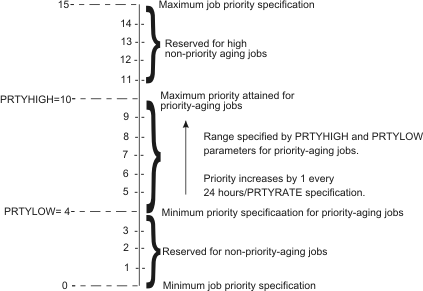 z/OS JES2 Initialization and Tuning Guide
z/OS JES2 Initialization and Tuning Guide
 z/OS JES2 Initialization and Tuning Guide
z/OS JES2 Initialization and Tuning Guide
|
Previous topic |
Next topic |
Contents |
Contact z/OS |
Library |
PDF
Job priority aging z/OS JES2 Initialization and Tuning Guide SA32-0991-00 |
|
|
The system can increase the priority of a job based on the amount of time since the job entered the system if it is in a job class managed by JES2 initiators. You define this ability by specifying PRTYHIGH=, PRTYLOW=, and PRTYRATE= on the JOBDEF initialization statement. PRTYHIGH= specifies the highest priority a job can achieve through automatic priority aging. PRTYLOW= specifies the lowest priority for a job to be eligible for automatic priority aging. PRTYRATE= specifies the number of times in a 24-hour period that the system will increase a job's priority (subject to the PRTYHIGH= limit) by one. PRTYRATE= has a default of 0, which means the system will not priority-age any jobs. For example, if PRTYRATE=48, PRTYLOW=4, and PRTYHIGH=10, then all jobs with priorities of 4 to 9 will have their priority increased by 1 every 30 minutes (that is, 24 hours / PRTYRATE of 48 = 30 minutes) until the job priority reaches priority 10. You set the lower priority limit, PRTYLOW=, to ensure that low priority work does not reach priority levels higher than new, more important work entering the system. In the previous example, all work with priorities 1, 2, and 3 will not priority age. You set the upper priority limit, PRTYHIGH=, to ensure that high priority work maintains its importance, and doesn't compete with work that achieved its priority from length of time in the system. In the previous example, work with priority 11 through 15, will not priority-age but maintains higher priority than any jobs that can priority-age. See Figure 1 for a graphic representation of the priority range setting. Figure 1. Example of the interaction
of priority-aging parameters, PRTYHIGH=, PRTYLOW=, and PRTYRATE= on
JOBDEF Statement
 When the job is on the HARDCOPY queue, the only way to affect the priority is through the output priority. For jobs that are run on a jobclass where MOD=WLM was specified on the JOBCLASS(n) initialization statement, job priority aging has no affect. 


|
 Copyright IBM Corporation 1990, 2014 Copyright IBM Corporation 1990, 2014 |